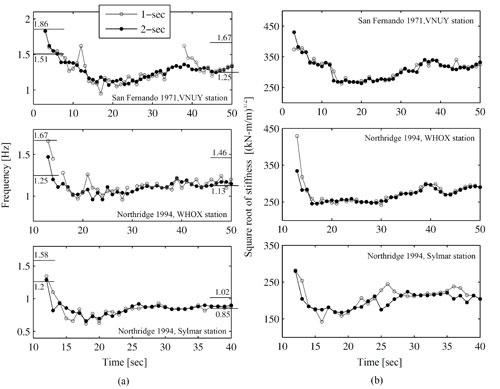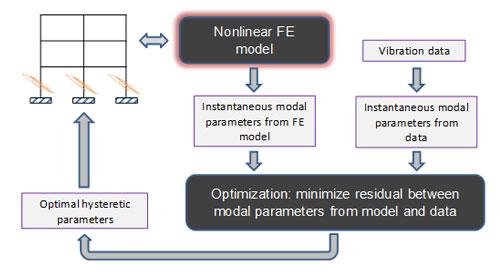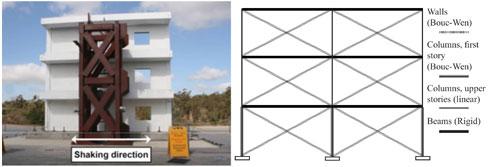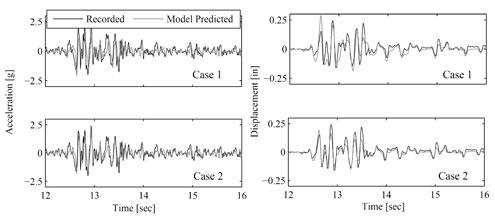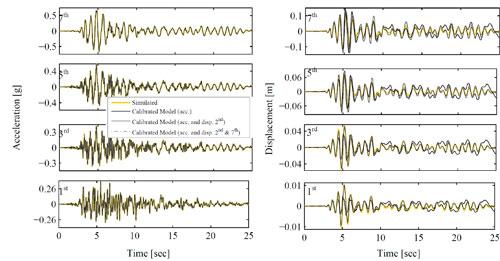Identification of Nonlinear Structural Systems
Research Team: Babak Moaveni (PI), Eliyar Asgarieh (grad student), Amin Nozari (grad student), Mingming Song (grad student)
Funding: NSF-CAREER (1254338)
Duration: 9/2011 – present
Relevant publications to date:
Asgarieh, E., Moaveni, B., and Stavridis A. (2014). "Nonlinear finite element model updating of an infilled frame based on identified time-varying modal parameters during an earthquake." Journal of Sound and Vibration, 333(23), 6057-6073.
Moaveni, B., and Asgarieh, E. (2012). "Deterministic-stochastic subspace identification method for identification of nonlinear structures as time-varying linear systems." Mechanical Systems and Signal Processing, 31, 40-55.
Asgarieh, E., Moaveni, B., Nozari, A., Barbosa, A.R., Chatzi, E. (2014). "Nonlinear identification of a seven-story shear wall building based on numerically simulated seismic data." Proc. of 32nd International Conference on Modal Analysis (IMAC-XXXII), Orlando, Florida, USA.
Asgarieh, E., Moaveni, B., and Stavridis, A. (2013). "Nonlinear finite element model updating of a large-scale infilled frame structure based on instantaneous modal parameters." Proc. of 31st International Modal Analysis Conference (IMAC-XXXI), Garden Grove, California, USA.
Asgarieh, E., and Moaveni, B. (2012). "Experimental modal analysis of a full-scale seven-story shear wall based on nonlinear seismic response." Proc. of 30th International Modal Analysis Conference (IMAC-XXX), Jacksonville, Florida, USA.
Asgarieh, E., Moaveni, B., and Stavridis, A. (2012). "Nonlinear structural identification of a three-story infilled frame using instantaneous modal parameters." Proc. of 30th International Modal Analysis Conference (IMAC-XXX), Jacksonville, Florida, USA.
Asgarieh, E., Moaveni, B. (2011). "Short-time modal identification of nonlinear systems using the deterministic-stochastic subspace identification method." Proc. of the 2011 Engineering Mechanics Institute Conference, Boston, Massachusetts, June 2-4.
This project includes the following sub-topics:
1. Modal Identification of Nonlinear Structures as Time-varying Linear Systems
This study proposes to use a linear system identification method to estimate the instantaneous modal parameters of a nonlinear structure. A windowed deterministic-stochastic subspace identification methods (DSI) was proposed for short-time (instantaneous) system identification of nonlinear systems when subjected to non-stationary seismic base excitations. Accuracy of this method is compared to that of the wavelet transform method when applied for identification of SDOF as well as 7-DOF systems with different material hysteretic behavior. Effects of several input factors on the accuracy of system identification results are studied. The considered input factors are: (1) type of material nonlinearity (i.e., material hysteretic behavior), (2) level of nonlinearity, (3) input excitation, and (4) length of the “short-time” data windows used in the identification. The contribution of each input factor to the total variability of two estimation error metrics is quantified through analysis-of-variance, an effect screening method.
The proposed DSI is also used for short-time system identification of a full-scale seven-story shear wall structure and a half-scale three-story RC frame structure when subjected to seismic base excitation through a shake table. The structures were damaged progressively through earthquake ground motions. This study highlighted the effectiveness of the DSI method for short-time (instantaneous) modal identification of nonlinear structural systems. It is expected that accurate estimates of instantaneous modal parameters to be used for characterizing the hysteretic behavior of structural components (e.g., substructures), which is the topic of an ongoing research by the research team. Figure 1 shows the time histories of the first mode instantaneous natural frequency of the test structure identified using 1- and 2-second windows during the three considered earthquake base excitation tests as well as the square root of an effective global stiffness estimate of the structure during the base excitation time histories. It can be observed that the identified instantaneous natural frequencies match well the trend of the square root of effective global stiffness estimate. It is expected that accurate estimate of instantaneous modal parameters can be used for characterizing the hysteretic behavior of the structure at element levels.
Figure 1. Time histories of (a) instantaneous fundamental natural frequency, and (b) square root of an effective global stiffness measure of the test structure, estimated using 1- or 2-second data windows during the three considered earthquakes
2. Nonlinear Finite Element Model updating
This study is focused on calibration of nonlinear model parameters (hysteretic material models) at considered finite elements (or substructures, assuming all elements in a substructure have similar nonlinear behavior) to match the identified time-varying modal parameters. The first step in modeling the nonlinear material behavior is to select the model class or type of constitutive relations. This is usually done based on prior information about the material. For example, the Menegotto-Pinto model for steel or the Takeda model for concrete are common hysteretic models for these two types of materials. Another class of phenomenological models includes the Bouc-Wen models, which are widely used to represent the hysteretic behavior (as lumped or distributed plasticity) of different structural materials/components. The number of parameters to be calibrated depends on the selected model class. For example, a Takeda model has five parameters while a Bouc-Wen model can take from 5 up to 13 parameters depending on whether stiffness degradation, strength degradation and pinching behavior are considered in the model or not.
Following the selection of model class and model parameters to be calibrated, the nonlinear FE model updating will be formulated as a nonlinear least squares. The objective function will be defined as the misfit between the identified modal parameters and their counterparts from the FE model. Figure 2 shows the nonlinear model updating process employed in this application example.
Figure 2. Nonlinear model updating process
The performance of the proposed updating method is evaluated through numerical and experimental applications on a large-scale three-story reinforced concrete frame with masonry infills (Figure 3). The test structure was subjected to seismic base excitations of increasing amplitude at a large outdoor shake-table. A nonlinear FE model of the test structure has been calibrated to match the time-varying modal parameters of the test structure identified from measured data during a seismic base excitation. The accuracy of the proposed nonlinear FE model updating procedure is quantified in numerical and experimental applications using different error metrics. The calibrated models predict the exact simulated response very accurately in the numerical application, while the updated models match the measured response reasonably well in the experimental application.
Figure 3. Test structure and the FE model to represent it
Figure 4. Comparison of model predicted roof acceleration (left) and first floor displacement (right) with their measured counterparts for two cases of model updating
3. Online Nonlinear Identification Using Unscented Kalman Filter
Adaptive methods such as Kalman or Particle filters have the potential for real-time nonlinear identification. In the application these methods, nonlinearity is modeled using analytical phenomenological material models such as the Bouc-Wen model. Although this framework has been applied successfully in many cases and promising results are reported, its applicability is hindered by problems such as large modeling errors in the considered state-space models (such as oversimplification of models, wrong boundary conditions and constraint assumptions, and incompatible nonlinear models) and difficulty of applying these models to more complex structural systems with large number of degrees-of-freedom. In this study, the applicability of an Unscented Kalman filter algorithm is investigated for identifying two nonlinear state-space models of a test structure relying on different modeling assumptions. The effects of these modeling assumptions on the performance of the implemented Kalman filter are studied.
Figure 5 represent the predicted acceleration and displacement responses at floors 1, 3, 5, and 7 of a seven story shear wall structure using the UKF. From this figure, it can be seen that, the calibrated model can accurately match the acceleration data while in the absence of the displacement measurements in the identification, the model displacements at the lower stories are estimated with some error.
Figure 5. Predicted acceleration and displacement responses of the model calibrated using the UKF based on either seven acceleration, seven acceleration and one displacement, or seven acceleration and two displacement channels of data
